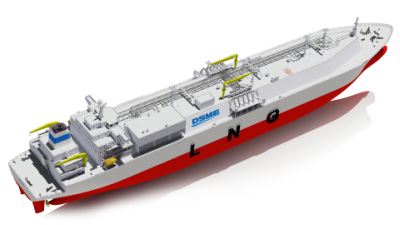DSME, DNV GL partner for efficient LNG carrier design
TOKYO -- At the Gastech 2017 conference in Tokyo, Japan, DSME and DNV GL presented the results of a joint development project (JDP) for the design of an innovative, efficient LNG carrier based on today’s technology. The project focused on delivering a design which an owner can take straight to the yard and is ready for upcoming market trends and incoming regulations, with an optimal size, hull form, and machinery and electrical systems.
 |
| Photo Courtesy of DNV GL. |
“When we look at today’s LNG market we predict that in the years to come we will see the rise of post-Panamax LNG carrier designs which are dimensioned to fit of the new Panama Canal. Capacities of over 175,000 m3 are feasible given the new restrictions,” said Johan Petter Tutturen, DNV GL – Maritime Business Director Gas Carriers.
An important consideration for the design is the shift towards lower, more energy-efficient transit speeds. The hull and propulsion system have been optimized for three different operating profiles on a standard transpacific route (19.5, 16 and 12 knots). Calm water optimization resulted in gains of 6%, 2% and 5% over the reference design at each of the three operating profiles. The optimization calculations were performed using the DNV GL hydrodynamic analysis software Wasim as well as statistics and Reynolds-averaged Navier-Stokes (RANS) simulations for determining wave resistance.
The design uses direct-coupled, two-stroke dual-fuel (DF) main engines and DF auxiliary engines, with LNG as the primary fuel. A combined gas turbine, electric and steam (COGES) propulsion system was chosen for the optimized machinery.
For the portion of the boil-off gas used as LNG fuel a “High Manganese Steel Cargo Tank Independent Type B” was chosen and underwent closed mock-up testing using liquid nitrogen (LN2). This was selected for its excellent tensile properties, high performance and product capacity at low cost, and allows flexible tank shapes while being slosh-free without imposing any filling limitations.
The design also incorporates DSME’s SloT (Ship Internet of Things) technology and their wireless computer network and integration system Smartship 4.0. In addition, the entire on-board computer environment underwent thorough testing to improve its cybersecurity.

- ExxonMobil halts 1-Bft3d blue hydrogen project in Texas
- Aramco and Yokogawa commission multiple autonomous control AI agents at Fadhili gas plant
- Ukraine will resume gas imports via Transbalkan route in November
- Mitsubishi to inject $260 MM into Brunei LNG project
- Freeport LNG (U.S.) on track to take in more natgas on Thursday after unit outage



Comments